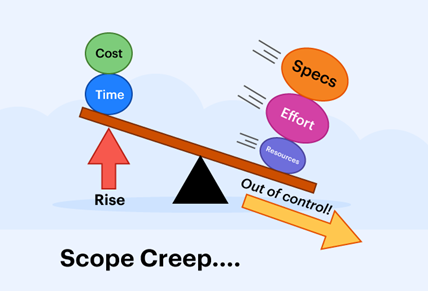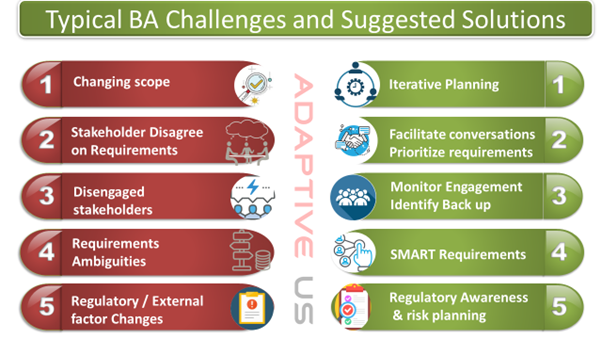Top 10 BA Challenges and Recommended Solutions
The Smartest Way to Learn is to learn from mistakes of others.
- LN Mishra, Co-founder, Adaptive US.
Business Analysts are often regarded as a crème de la crème of professionals and are coveted by many. Business analyst is a key role along with the Project Manager responsible for the success or failure of any project/initiative. While Business Analysts are the agents of organizational change, are influential and have significant strategic importance. However, the Business Analyst role also comes with its own share of challenges.
Most large projects are time sensitive, often quite technical, and involve many stakeholders. Business analysts are responsible for eliciting requirements from various stakeholder groups, getting them signed off, and ensuring requirements are effectively developed, tested, and deployed for end users. While this may sound simple and straightforward, business analysts face several challenges at each step of the project.
Some of the key challenges that should be kept in mind in order to deliver the best results are discussed in this article.
1. Scope Creep

Image source – kissflow.com
Scope creep occurs when changes are made to the agreed-upon requirements. For example, the timeline and plan were agreed upon when the requirements were identified. Then stakeholders come up with a new requirement and expect the solution to be delivered in the same timeline. Scope creeps invariably put the project team under undue pressure. This issue is more prevalent in waterfall projects as stakeholders get very little opportunity to provide feedback on the solution being developed. Although sprint planning takes reasonable care of feature changes with agile projects, they still run the risk of scope creep at an initiative level.
Suggested solution/prevention – Keeping a close watch on team capacity availability to deliver project work is essential. A new feature introduction should be matched with additional resources (time, capacity) or a reprioritization of already planned features.
2. Constant changes in requirements or their priorities

Image source – freepik.com
It is tough for stakeholders to express their precise needs, be it designing the interiors of a house, which course to pursue, etc., as the list goes on. In addition, there are often situations when the need is unclear in the beginning in terms of detailing the requirement, priority, etc., and stakeholders/users are unsure about the functionality they need. As a result, requirements are not defined effectively, requiring frequent changes to the requirements.
Suggested Solution / Prevention – For this, the first step should be to understand the reason which led to such changes. Then, once the reason is apparent, apply the requirements prioritization process. This would improve the requirements management process. Finally, keep a hawk's eye on the value that the requirements change brings and the costs incurred to make the change happen.
3. Delay or Missing Stakeholder Agreement or Sign off

There could be a variety of reasons for a delay in stakeholders' sign-off, such as
- Unavailability of key stakeholders
- Inadequate involvement of stakeholders
- Lack of agreement /consensus on the requirements
Suggested solution/prevention -
- Try to find a backup for the key stakeholder and invite/engage with them.
- Prepare a business case to present and obtain feedback from the user group/stakeholders in one meeting where you bring along the project sponsor or a highly influential stakeholder.
- Call for a meeting to discuss the requirements and get them signed off – prepare the meeting minutes, distribute them to all the stakeholders and ask everyone to review the points to come back for any disagreements.
4. Change of business/process ownership
Change of business/process ownership is often a serious risk to the project and its success. It comes with problems like
- Change of business/process owner priorities
- Lack of contextual knowledge of the solution needs
- Lack of ownership of the existing initiative as the previous business/process owner created it
Suggested solution/prevention –
- Keep an eye to see if there is a likelihood of such a change in the organization
- Slowdown on investment or effort spent
- Prepare to explain the value of the initiative to the new business/process owner
Nonalignment of goals among business owners

Image source – freepik.com
Nonalignment of goals among stakeholders can lead to changing needs and priorities. This can pose serious impediments to the project's progress.
Suggested solution/prevention -
- Agile projects have the provision/option of taking up features based on priority in subsequent iterations or sprints
- Prioritizing the must-have features and features that can be taken up in future releases using MOSCOW prioritization will be a big help.
Regulatory / External factor changes

Image source – freepik.com
Suppose you are a business analyst in a regulated industry or where regulatory requirements come into play. In that case, you must remember that regulations or compliance changes can affect multiple systems, geographies, and projects differently.
Suggested solution/prevention -
A high-level understanding of your organization's regulatory environment and how it can affect the projects will help you develop systems that comply with regulatory requirements as efficiently as possible. This can be done by developing requirements in close interaction with stakeholders with regulatory and compliance backgrounds. In addition, developing a foundational knowledge of the domain is always beneficial to be cognizant of the changes and their impact.
7. Lack of Stakeholders Engagement
Active stakeholder engagement and management are undoubtedly critical success factors for any project. Interacting with the various stakeholders and understanding their characteristics can help devise strategies to address their expectations and concerns.
Understanding the interest of the stakeholders and aligning it with the project goals is an important responsibility for the BAs. Some stakeholders may become influential or disinterested altogether as the project develops. If the stakeholder has a critical role in the project, their non-involvement will pose a serious risk to its success.
Suggested solution/prevention -
It is crucial to keep an eye on these changes. Modifying the engagement techniques with the stakeholders should be considered considering its potential impact on the project. A stakeholder map is helpful in effective engagement with the stakeholders according to their interests and influence on the project.
Gaps in the Project Management Process
Some of these common misses in the project management process make the project go through rough patches, unreasonable workloads, and missed deliveries:
- Inadequate risk planning – Identifying risks post-change / new solution implementation
- Inadequate resource planning – not considering backup (non-billable resources) for key resources resulting in a delay in knowledge transfer in case of attrition which impacts the entire project and puts pressure on team members to take up an unplanned activity.
- Inadequate business analysis planning – Project managers are in a hurry to start the project without adequate BA planning. This leads to gaps in the BA process later on in the project.
Suggested solution/prevention –
- Stronger focus on project management principles in business analysis activities
- Resource pool with prior experience in similar project /domain expertise
- Be a part of the project planning process
Unable to showcase ROI
Measuring the effectiveness of any task is essential to know whether the task is value-adding or not. Return on Investment is one of the most effective methods to evaluate the effectiveness of the business investment made on any initiative. Business analysis is no exception to this. Knowing the business benefits and costs enables BAs to justify initiatives and plan future activities.
Suggested solution/prevention -
Ways to measure metrics for ROI by the initiatives of the BA
- Cost saving in $$ by process improvement by the BA
- Revenue improvement due to technical upgrade/automation
- New business generation due to new tech adoption/process improvement /automation
- Efforts saving $$ due to the process improvement
- Quality improvement/defect reduction benefits in $$ due to the process improvement
10. Resistance to acceptance of the new system
Change is always inevitable, but so is resistance to change. It is a natural tendency of many stakeholders to try and keep their methods and systems unchanged. Implementing a change is always hard, especially if it's a system that users have been habituated to for a long time despite its flaws and inefficiencies. Stakeholders are used to their processes, even if a majority of them are time-consuming and manual. So, learning all over again on a brand-new system is not always received well. In fact, sometimes, some fight it all the way to reject the new system being kicked off.
Suggested solution/prevention -
- Highlight the benefits of the new system to the users
- Showcase the users how it will benefit them – ease of use, improved features/functionalities, benefits in their day-to-day tasks
- Work with them in the transition process
- Work with them to gain the trust of the users' team.

Conclusion
As the business analyst profession is strategic and rewarding, similar are the associated challenges. The challenges are of varying levels of complexity each day. However, the ones mentioned above are the most commonly experienced ones shared by the BA community in this LinkedIn Post and are faced by nearly every organization.
An overall solution to these problems would be to have the required knowledge, skill, patience, and perseverance to handle the situation. However, you can manage the challenges much better and be a proficient BA by enhancing your business analyst skills with the various Business Analyst Courses.
You May Also Like
These Related Stories

Business Analyst Training in 2025 | 100% Success Guarantee

Top Business Analyst KPIs for 2025: Free Template



Comments (2)